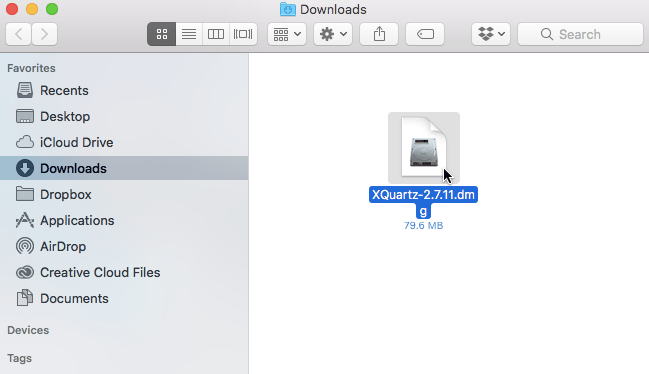

- DOWNLOAD XQUARTZ WITH BREW HOW TO
- DOWNLOAD XQUARTZ WITH BREW INSTALL
- DOWNLOAD XQUARTZ WITH BREW PLUS
- DOWNLOAD XQUARTZ WITH BREW DOWNLOAD
Both worked fine for me with a Core 2 Duo processor ( -j 2 and -j 3).
DOWNLOAD XQUARTZ WITH BREW PLUS
I’ve heard arguments saying that the integer argument should be related to the number of cores on your processor and the number of cores plus one. The -j flag is the jobs flag and allows the compiler to execute multiple jobs simultaneously, rather than running a linear compilation. If there any other ROOT options you want changed, the cmake command is the place to specify them. If you don’t set these flags explicitly CMake may use the GNU compiler gcc for the C_COMPILER and Clang for the CXX_COMPILER, which causes errors. The C_COMPILER and CXX_COMPILER are both Clang. $ cmake /usr/local/root/src -DCMAKE_INSTALL_PREFIX =/usr/local/root -DCMAKE_C_COMPILER =clang -DCMAKE_CXX_COMPILER =clang++ -Droofit =ON We use a few compilers here ( clang, clang++, gfortran), so which compiler needs the flags? I got the compilation to work with the following. Luckily StackOverflow provided the answer, saying to pass the required directory as a compiler flag.
DOWNLOAD XQUARTZ WITH BREW INSTALL
The compiler didn’t pick up my XQuartz install so couldn’t find X11/Xlib.h. I stumbled a lot here, mainly because of X11.

All that’s left is the compilation with make. Unzip the tarball and move it to a src directory.
DOWNLOAD XQUARTZ WITH BREW DOWNLOAD
Create the directory and download ROOT in to it with cURL. We’ll be installing ROOT in to the same directory that Homebrew installs things in to, but you can choose whichever directory you like (preferably one which your user owns to avoid lots of sudo). That’s everything required for ROOT to install. (The only one to really take notice of is the Python installation, where you might like to use the symlinks provided and add the install-scripts folder to your PATH.) You can read the post-install caveats any time by reading the appropriate recipe. $ brew install cmake # Cross-platform make $ brew install fftw # Fast Fourier Transforms $ brew install pcre # Regular Expressions library $ brew install python # Python interpreter $ brew install gfortran # Fortran compiler Each may take some time as Homebrew generally compiles from source. Now that Homebrew is installed, we can use it to install the required dependencies. Start a new Terminal session to pick up the changes. export PATH =/usr/local/bin:/opt/X11/bin: $PATH We’ll also add the XQuartz binaries to the PATH in case anything needs them in the future. zshrc or whatever shell file you’re using (. Remember to add the Homebrew directory to your PATH by adding the directory (found with brew -prefix) to your. If there’s any of them that look particular troubling, Googling almost always uncovers someone with the same problem. $ ruby < ( curl -fsS )Ī lot of the warnings that brew doctor produces can safely be ignored (at least for our purposes). Next, launch Terminal (inside /Applications/Utilities/) and install Homebrew. Mount the disk image and use the package install inside. Choose to install the “Command Line Tools” option.įinally in preparation for Homebrew, as Mountain Lion doesn’t ship with X11, download XQuartz 2.7.2 or later. Once it’s downloaded and installed, open Xcode, then open the following menu items in order: Xcode, Preferences, Downloads, Components. Xcode, Apple’s development environment, is required before installing Homebrew. It has several dependencies which are required for compilation we’ll use Homebrew to install them. ROOT is distributed as source, so to install it we must download and compile. We’ll be installing ROOT to its own directory, so if something goes wrong during the install just delete the directory and try again. The following assumes you’re OK using the command line, though all the commands needed are given, and are running OS X 10.8 Mountain Lion. (I wanted to use cmake for the Xcode integration). The only 10.8 ROOT tutorial I’ve found uses the make make install path and doesn’t enumerate any of the available configuration options.

I recently found myself needing to install ROOT, the high energy physics framework by the folks at CERN.
DOWNLOAD XQUARTZ WITH BREW HOW TO
With Mountain Lion, the latest version of OS X, having been recently released, there’s been the usual flurry of blog posts on how to survive the upgrade.

Running OS X 10.9 Mavericks? Check out the latest tutorial.


 0 kommentar(er)
0 kommentar(er)
